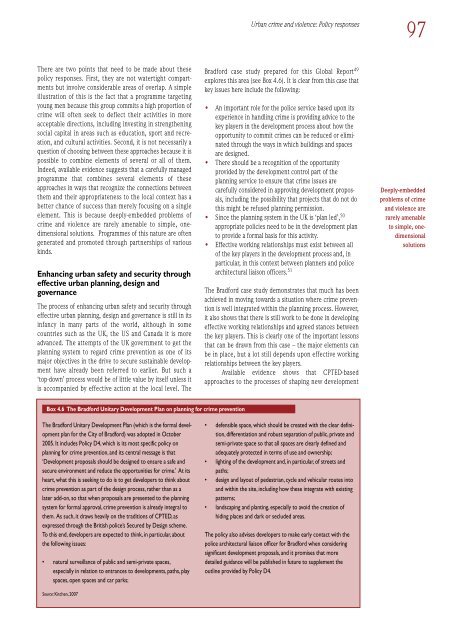Download the file - United Nations Rule of Law
Download the file - United Nations Rule of Law
Download the file - United Nations Rule of Law
- No tags were found...
Create successful ePaper yourself
Turn your PDF publications into a flip-book with our unique Google optimized e-Paper software.
Urban crime and violence: Policy responses97There are two points that need to be made about <strong>the</strong>sepolicy responses. First, <strong>the</strong>y are not watertight compartmentsbut involve considerable areas <strong>of</strong> overlap. A simpleillustration <strong>of</strong> this is <strong>the</strong> fact that a programme targetingyoung men because this group commits a high proportion <strong>of</strong>crime will <strong>of</strong>ten seek to deflect <strong>the</strong>ir activities in moreacceptable directions, including investing in streng<strong>the</strong>ningsocial capital in areas such as education, sport and recreation,and cultural activities. Second, it is not necessarily aquestion <strong>of</strong> choosing between <strong>the</strong>se approaches because it ispossible to combine elements <strong>of</strong> several or all <strong>of</strong> <strong>the</strong>m.Indeed, available evidence suggests that a carefully managedprogramme that combines several elements <strong>of</strong> <strong>the</strong>seapproaches in ways that recognize <strong>the</strong> connections between<strong>the</strong>m and <strong>the</strong>ir appropriateness to <strong>the</strong> local context has abetter chance <strong>of</strong> success than merely focusing on a singleelement. This is because deeply-embedded problems <strong>of</strong>crime and violence are rarely amenable to simple, onedimensionalsolutions. Programmes <strong>of</strong> this nature are <strong>of</strong>tengenerated and promoted through partnerships <strong>of</strong> variouskinds.Enhancing urban safety and security througheffective urban planning, design andgovernanceThe process <strong>of</strong> enhancing urban safety and security througheffective urban planning, design and governance is still in itsinfancy in many parts <strong>of</strong> <strong>the</strong> world, although in somecountries such as <strong>the</strong> UK, <strong>the</strong> US and Canada it is moreadvanced. The attempts <strong>of</strong> <strong>the</strong> UK government to get <strong>the</strong>planning system to regard crime prevention as one <strong>of</strong> itsmajor objectives in <strong>the</strong> drive to secure sustainable developmenthave already been referred to earlier. But such a‘top-down’ process would be <strong>of</strong> little value by itself unless itis accompanied by effective action at <strong>the</strong> local level. TheBradford case study prepared for this Global Report 49explores this area (see Box 4.6). It is clear from this case thatkey issues here include <strong>the</strong> following:• An important role for <strong>the</strong> police service based upon itsexperience in handling crime is providing advice to <strong>the</strong>key players in <strong>the</strong> development process about how <strong>the</strong>opportunity to commit crimes can be reduced or eliminatedthrough <strong>the</strong> ways in which buildings and spacesare designed.• There should be a recognition <strong>of</strong> <strong>the</strong> opportunityprovided by <strong>the</strong> development control part <strong>of</strong> <strong>the</strong>planning service to ensure that crime issues arecarefully considered in approving development proposals,including <strong>the</strong> possibility that projects that do not dothis might be refused planning permission.• Since <strong>the</strong> planning system in <strong>the</strong> UK is ‘plan led’, 50appropriate policies need to be in <strong>the</strong> development planto provide a formal basis for this activity.• Effective working relationships must exist between all<strong>of</strong> <strong>the</strong> key players in <strong>the</strong> development process and, inparticular, in this context between planners and policearchitectural liaison <strong>of</strong>ficers. 51The Bradford case study demonstrates that much has beenachieved in moving towards a situation where crime preventionis well integrated within <strong>the</strong> planning process. However,it also shows that <strong>the</strong>re is still work to be done in developingeffective working relationships and agreed stances between<strong>the</strong> key players. This is clearly one <strong>of</strong> <strong>the</strong> important lessonsthat can be drawn from this case – <strong>the</strong> major elements canbe in place, but a lot still depends upon effective workingrelationships between <strong>the</strong> key players.Available evidence shows that CPTED-basedapproaches to <strong>the</strong> processes <strong>of</strong> shaping new developmentDeeply-embeddedproblems <strong>of</strong> crimeand violence arerarely amenableto simple, onedimensionalsolutionsBox 4.6 The Bradford Unitary Development Plan on planning for crime preventionThe Bradford Unitary Development Plan (which is <strong>the</strong> formal developmentplan for <strong>the</strong> City <strong>of</strong> Bradford) was adopted in October2005. It includes Policy D4, which is its most specific policy onplanning for crime prevention, and its central message is that‘Development proposals should be designed to ensure a safe andsecure environment and reduce <strong>the</strong> opportunities for crime.’ At itsheart, what this is seeking to do is to get developers to think aboutcrime prevention as part <strong>of</strong> <strong>the</strong> design process, ra<strong>the</strong>r than as alater add-on, so that when proposals are presented to <strong>the</strong> planningsystem for formal approval, crime prevention is already integral to<strong>the</strong>m. As such, it draws heavily on <strong>the</strong> traditions <strong>of</strong> CPTED, asexpressed through <strong>the</strong> British police’s Secured by Design scheme.To this end, developers are expected to think, in particular, about<strong>the</strong> following issues:• natural surveillance <strong>of</strong> public and semi-private spaces,especially in relation to entrances to developments, paths, playspaces, open spaces and car parks;• defensible space, which should be created with <strong>the</strong> clear definition,differentiation and robust separation <strong>of</strong> public, private andsemi-private space so that all spaces are clearly defined andadequately protected in terms <strong>of</strong> use and ownership;• lighting <strong>of</strong> <strong>the</strong> development and, in particular, <strong>of</strong> streets andpaths;• design and layout <strong>of</strong> pedestrian, cycle and vehicular routes intoand within <strong>the</strong> site, including how <strong>the</strong>se integrate with existingpatterns;• landscaping and planting, especially to avoid <strong>the</strong> creation <strong>of</strong>hiding places and dark or secluded areas.The policy also advises developers to make early contact with <strong>the</strong>police architectural liaison <strong>of</strong>ficer for Bradford when consideringsignificant development proposals, and it promises that moredetailed guidance will be published in future to supplement <strong>the</strong>outline provided by Policy D4.Source: Kitchen, 2007
















